
The Best of Everything
Encyclopedia Entry • Films Main
Strange Cargo
1940

Critics' Reviews • Our Reviews • Movie Posters • Lobby Cards • Misc. Images
Click here to see photos from the film.
US release: 3/1/40
VHS release: 12/5/90 DVD release: 2/12/08 (as part of "Joan Crawford Collection Vol. 2") Cast: Joan Crawford (as "Julie"), Clark Gable, Ian Hunter, Peter Lorre, Paul Lukas, Albert Dekker, J. Edward Bromberg, Eduardo Ciannelli, John Arledge, Frederic Worlock, Bernard Nedell, Victor Varconi. Credits: Based on the 1936 novel Not Too Narrow, Not Too Deep by Richard Sale. Screenplay: Lawrence Hazard. Producer: Joseph L. Mankiewicz. Director: Frank Borzage. Camera: Robert Planck. Art Director: Cedric Gibbons. Music: Franz Waxman. Editor: Robert J. Kern.
Plot Summary: "Strange" is right: this mystical MGM melodrama has to be the oddest of the studio's Clark Gable-Joan Crawford vehicles. When eight prisoners escape from a New Guinea penal colony, they are picked up by a sloop commandeered by another escapee named Verne (Gable) and his trollop girl friend Julie (Joan Crawford). Among the fugitives is Cambreau (Ian Hunter), a soft-spoken, messianic character who has a profound effect on his comrades. One by one, the escapees abandon their evil purposes and find God-and a peaceful death--through the auspices of the Christlike Cambreau. The last to succumb to Cambreau's ministrations is Verne, who agrees to return to return to the prison colony serve out his sentence if Julie will wait for him (which she does). A superb Franz Waxman score provides a touch of show-biz grandeur to this haunting fable. ~ Hal Erickson, All Movie Guide
Notes: • In production from 10/17/39 to 12/28/39 in Laguna, CA, and Pico, Montebello, CA. • Banned in Rhode Island and Cleveland, Ohio, for "lustful implications in dialogue and situations." • According to MGM's Eddie Mannix Ledger, the film earned $1,311,000 in the US and Canada and $603,000 elsewhere, for a profit of $21,000.
|
The supernatural idea inherent in the book "Not Too Narrow, Not Too Deep" has been pretty thoroughly obscured without actually being removed from the long and violent melodrama "Strange Cargo," which was unloaded yesterday at the Capitol Theatre. As it stands, the allegory is certainly not too deep, but it does seem a bit too narrow to accommodate itself readily to the broad and brutal sweep of the penny-dreadful narrative. Another technical disadvantage arises from the star system by which Clark Gable and Joan Crawford must take the picture away from its most important character, the mysterious stranger whose shadow has not passed here since "The Passing of the Third Floor Back." Due to their concerted efforts, the stranger is no more and no less impressive than an actor with third billing by the name of Ian Hunter. Yet if such a role must exist at all amid the conventional terrors of a jungle-and-sea-escape from a cinematic tropical prison it should be much more portentous than Mr. Hunter has been allowed to make it. The gentle and forgiving spirit known as Cambreau is hardly the sort of character to play second-fiddle even to Miss Crawford and Mr. Gable, and the picture is no better than a passable tropical melodrama in consequence of his unnatural suppression. All the others we have met dozens of times before in similar circumstances — Peter Lorre, the commandant's stool pigeon; Paul Lukas, the cynical thief and philosophical worldling; Albert Dekker, the brutal killer, who, it appears, nevertheless has a heart; Eduardo Ciannelli, the religious fanatic, and so on. But when Mr. Hunter walks into the picture, a miraculous thirty-sixth prisoner to silence the gate-checker's clamor, something more should have been made of him than simply an unaccountable stooge to cover Mr. Gable's amorous adventurings with Miss Crawford in the town cabaret. We do not know who this character Cambreau may be, and we dare not define him, for it is evident that, although he flees with the escaping prisoners, shares their hardships in the jungle, suffers hunger and thirst with them in an open boat during a long calm at sea, he is not a natural man. His uncanny directional sense, his prophetic attitude toward human and meteorological events, his accurate foreknowledge of how everything is going to turn out (one piece of insight which an experienced moviegoer may well share with him) all argue for some super-terrestrial origin. Yet the ultimate result of his labors and teachings in behalf of the erring mortals who surround him is the usual melodramatic ending, with Gable penitently going back to finish his prison term and with Joan obviously planning to wait for him. Anything else, of course, would have been a miracle which even the miraculous Cambreau could hardly have been expected to accomplish.
Film Daily (1940) Here is a good, raw, stark melodrama which holds suspense from the start....The acting is high-grade with Joan Crawford giving her best performance to date.
Variety (1940) Miss Crawford is provided with a particularly meaty role as the hardened dance-hall gal who falls hard for the tough convict. Role is a departure from those handed her during past several years by her studio, and reminiscent of her earlier work that carried her to popularity originally. Although the picture has its many deficiencies, the Crawford characterization will give studio execs idea of proper casting of her talents for the future.
MoriaReviews.com (1999) Strange Cargo has a title that could mean anything. It certainly gives no hint of what is surely one of Hollywood’s strangest allegory plays. The film starts out as a Devil’s Island escape drama. The initial build up is as torrid quasi-noir and it is not until the latter third of the film that the film starts to get interesting. During these scenes, the film transforms into a peculiar parable where it becomes apparent that one of the strangers along for the journey is, if not actually then at least allegorically, Jesus Christ. Full review. |
If you've seen Strange Cargo and would like to share your review here, please e-mail me. Include a photo of yourself or avatar, a star-rating (with 5 stars the best), and any of your favorite lines from the film.
|
Rating:
I just watched Strange Cargo (1940) for about the fourth or fifth time, but the first time since I read the source book Not Too Narrow...Not Too Deep by Richard Sale (1936) earlier this year. I cannot add much above and beyond what Stephanie has said by way of cinematic scrutiny, which is among the best analyses of a JC film I have read. Strange Cargo grows in my estimation every time I watch it, in terms of the acting by the principles---Joan and Clark---and by the supporting cast, most notably Ian Hunter as Cambreau, as well as the underlying themes. Kudos are especially due Frank Borzage---who directed Joan in one of her earliest roles (Young Lady Catherine, The Circle, 1925) plus two later films---for the movie not getting bogged down or overly convoluted, because Strange Cargo is three movies in one. First, and stop me if you've heard this before, there is a love story between Gable and Joan! Since they are, in my opinion, the greatest screen pairing of all time, not only do they own the screen when they're together, they look to be having a grand time reacting to each other. Delete other aspects of this film, and JC/CG hooking up to live happily ever after makes it satisfying. Their banter is electric, and the sexual chemistry between them is instantaneous from first meeting. One of my favorite Crawford lines comes from their initial meeting on the docks, which has Joan blurting out, “You’d like to cut yourself a piece of cake like that, wouldn't you?” (Joan’s recipes are legendary, but she’s not talking confections. And the look on Clark’s face tells you all you need to know where he stands vis-a-vis Joan’s baked goods!) Second, there is the prison escape aspect, which is gripping: the actual escape, eluding the guards, navigating the jungle and a merciless sea, sharks, thirst, avoiding capture, machinations between a band of cutthroats, etc. And finally, intertwined with the two aforementioned plots, there is a very well done story of redemption for these hardened criminals and fallen people who are attempting to escape a penal colony in French Guiana. Through their interaction with Cambreau, a mystery who materializes out of thin air and whom many reviewers consider a Christ-like figure, the convicts plus Joan’s character (Julie, a down-on-her-luck singer in a sleazy bar in the penal colony) are brought to salvation---or not, as in the case of the unredeemable Hessler. As you might imagine, it is a very fine line between telling such a tale without being overly preachy. Bravo to Borzage: He does exactly that. There is just enough to be thought-provoking, but not so much as to detract from the adventure/love threads of Strange Cargo. I did a review of Sale’s book for the BOE website, and the biggest difference between book and screenplay is that the book has no Julie. So, by default, I think the movie is better. However, I don’t think the movie would have been as good without Joan’s character, her acting, the Crawford/Gable romance (their 8th and final pairing), and the spark she brings to the film, not to mention how her own tale of salvation plays out. That said, reading the book helped fill in some things that were not clear to me upon my initial viewings of Strange Cargo, so I highly recommend it. The book is reasonably available given its age, and can be found for a reasonable price on used-book sites. For a dedicated early Joan-aphile, this may be my favorite among her "later" movies.
Rating:
When I come upon a dismissive Crawford person, I show them “Strange Cargo.” This movie can captivate even the most uninterested Crawford detractor. Is it because of the mostly all-male cast and the Devil’s Island surroundings? (Steve McQueen could have played Gable's role in a remake.) Is it Ian Hunter as the pseudo-Christlike figure? Is it the homosexual innuendo? Or a woman alone on a boat with only men (all escaped criminals)? What is the attraction?
Personally, I think it is Peter Lorre; he is such a creepy, slimy creep, you can feel Miss Crawford’s body cringe every time she sees him. She did not have to go to Warner’s for him: Lorre came to MGM for her. And teaming them in a movie together is one of the cinema's great treats: like Sydney Greenstreet later, and how I wish the studio had paired Miss Crawford with Humphrey Bogart.
The sublime casting does the rest: Paul Lukas -- his voice alone keeps your attention. Eduardo Ciannelli (great in "Marked Woman" with Bette Davis) -- a wonderful mobster-gangster and typical mean guy, here he is very religious and plays it up to the last jungle bite. Albert Dekker is an absolute macho bully but I liked him, and I knew Gable was going to beat him; however, he put up a good fight. J. Edgar Bromberg is a special, sensitive character actor. These men pull out all the stops and they make “Strange Cargo” actually very strange at times.
Now, as for Miss Crawford: She is a tough broad here (yes, with a sensitive side). Life has not been easy for “Julie,” and she certainly pays for it later; she may be a low-life, but she was a good sport and ended up having a deeper side to her that even the writers didn’t know about, and a sense of personal growth that only made her more human and wise. It is a fantastic role, and not many actresses of the day could have attempted the role of “Julie.” (Tallulah Bankhead would come close in “Lifeboat," but she had a good job, cigarettes, furs, jewels, and Alfred Hitchcock.) Miss Crawford proves she is a versatile actress. Her acting is top-notch!
Mr. Mankiewicz gives us and Miss Crawford one last shot at an almost-great movie, and after this he gives us “Reunion in France ”? Joe, what happened? Was it the Cadillac?
The director Frank Borzage (an intense and quiet man) finished his trio of Joan movies with memorable performances by Gable and Crawford. He did what he could with the script and worked in Ian Hunter's character with some plausibility. I would like to find the book and see the difference.
You've got to love it when Julie throws the frying pan at her kidnapper/rapist to protect Gable and herself. (I rewind that scene so many times.) It is after that scene that all my friends love the rest of the movie, and they review Miss Crawford with a new, open interest.
A great film for late nights or dark and cloudy days.
Rating:
In "Strange Cargo," Joan exchanges the $40,000 wardrobe from her previous film "The Women" for 3 dresses worth $40. But one senses that had the feisty, very urban, edge-of-society shop-girl "Crystal" been set adrift with a boat-load of island convicts, she and Cargo's "Julie" might have reacted very similarly.
Like Crystal, Julie's a tough cookie, used to giving herself as chattel to make her way in the world. While the exchange of sex as a means of livelihood is heavily glitzed up and glossed over in "The Women," here in Cargo, there are no such illusions or outer trappings: Julie must offer herself up to the least objectionable man, not for jewels or a better apartment, but rather for her very survival.
While "The Women" wallows in the decadence, however, "Cargo," despite its rough, surfacely immoral characters, is actually the much more redemptive, hopeful picture. (Oddly, but actually predictably, it was "Cargo" that was condemned by the Catholic Legion of Decency, and actually banned in Boston -- despite "The Women"'s overt obeisance to the shallow god of luxury.)
"Cargo," on the surface, is an action tale. Its hero, Verne (Clark Gable, in his first film after his stunning success in GWTW; Joan won this battle over top billing), is desperate to escape from a penal colony and hooks up with a motley crew of prisoners hell-bent on the same goal. (With Joan's bar-singer "Julie" -- who does not appear in the novel -- thrown in for good measure.) The fellow prisoners range from a serial wife-murderer ("Hessler," played by Paul Lukas) to a Christlike figure ("Cambreau," Ian Hunter) to the tough-guy mastermind of the escape plot ("Moll," Albert Dekker), who has a thing for "The Kid," his weak-but-affectionate male sidekick.
(A sidenote: Though Joan said in a later interview when asked about the seemingly gay relationship between Moll and The Kid: "We had enough trouble with a Christ figure, for Pete's sake, let alone homosexuals," the connection between Moll and Kid is fairly obvious: When Moll and Verne fight on the beach, the camera focuses on Julie and The Kid looking on with similarly distressed expressions; later, Moll gives a ship-board speech about how The Kid would have missed him if he died in the same way that Julie would miss Verne.)
Action/fights aside, "Cargo" is primarily an allegorical story of redemption. Hunter's saintly "Cambreau" is highly symbolic, seemingly far too good to be true. Yet his character's effect on his cohorts is not overdone or smarmy. His presence is a quiet one; he acts as a catalyst, bringing out the true nature of the desperados around him. To a dying, religious convict whose cross has been stolen and who feels forsaken, Cambreau points out that "the miracle is not in the wood of the crucifix, but in the heart." To the hard-boiled and doubting Julie and Verne, Cambreau subtly makes an ultimately inspiring case for love and faith. (In a scene reminiscent of 1932's "Rain," Julie at one point doubts Cambreau's sincerity: "I know that routine. It starts out with a prayer and ends up with a bible in one hand and me in the other." Unlike the Reverend Davidson, however, Cambreau proves himself trustworthy.)
"Strange Cargo" is based on the novel "Not Too Narrow...Not Too Deep" by Richard Sale. The novel title is referenced in the book with the Part II epigram: "Dig not too narrow, not too deep, that I may come forth," referring to humans' ability to ascend from their graves at the Resurrection. Author Sale later states in the text, "The grave is humanness." Early on in the film, one prisoner says of his fellow inmates, re their own mental graves: "They've dug them too narrow, too deep. They can't get out."
Cambreau represents each flawed human's effort to escape the grave of his or her own making. Julie and Verne are proof of his teachings, because Cambreau has simply illuminated their true inner natures -- their capacity for love and faithfulness. (The wife-killer Hessler, on the other hand, who has been called "The Devil," also stays true to himself; a tribute to the film's honesty -- and perhaps a main reason for the film's banning -- he is not punished and manages to escape into the night.)
Joan, sans makeup and wardrobe, is amazing here. She starts out as the prototypical hard-edged bar-girl in a tough situation -- (sexily) biting and kicking and forcibly submitting to similar abuse...yet winds up opening her heart to Verne, a similarly defiant, frightened soul. Joan's best scene is the one with Gable in front of the campfire as they're making their way to the boat. She tries to prettify herself in the reflection of a tin-can lid, smoothing her hair, attempting unsuccessfully to apply lipstick. Verne watches her, amused, and sarcastically reads from the bible that Cambreau has given him: "Behold, thou art fair, love...Thou hast ravished my heart."
Julie's subsequent breakdown at his mockery is subtle and heartbreaking. And yet telling. She's finally let herself appear weak before the man she loves.
Once the pair have made it to the boat, Julie's tough-girl persona reasserts itself. When it's suggested by Moll that "the weak" (such as the sole woman on-board) may be weeded out, she proclaims: "I'm sorry to disappoint you gorillas, but I feel fine." To which Verne responds, affectionately, tousling her hair, "You're the second best man in the boat, baby."
The two -- Julie and Verne -- have pulled through, and pulled through together, with trust for each other, despite their blatant weaknesses and past betrayals.
Action tale, morality tale, what-have-you. "Strange Cargo" is, above all, a love story with Joan at her stripped-down, subtle acting best.
|
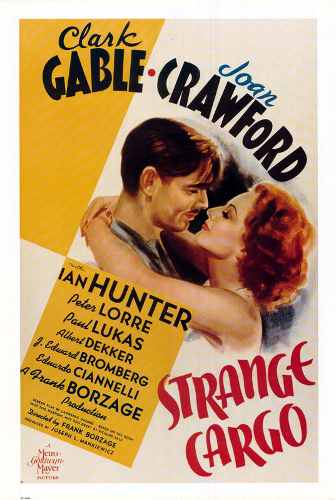

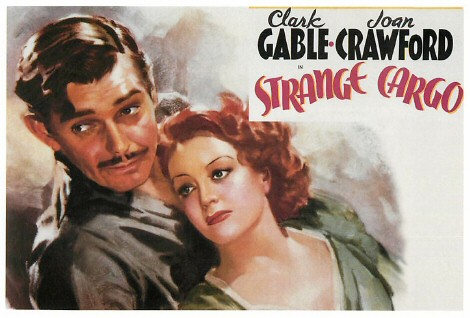


Above: US movie posters.
Below: Belgium, Denmark, Italy.
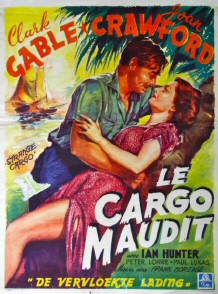

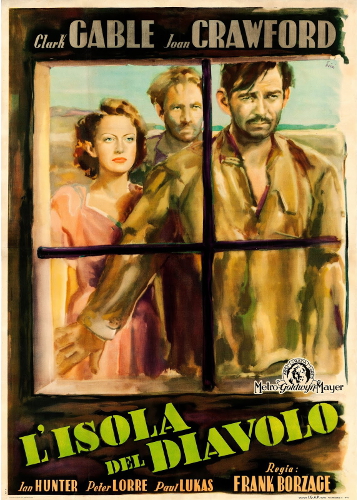
Below: Eight US "Color Glo" lobby cards.








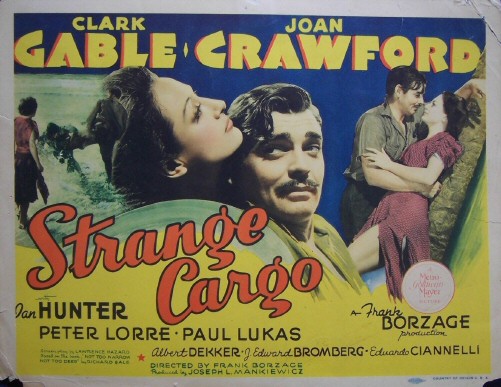
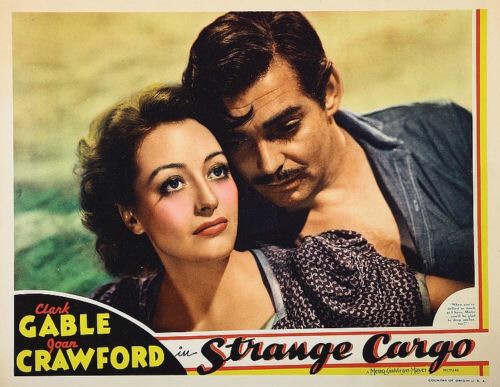
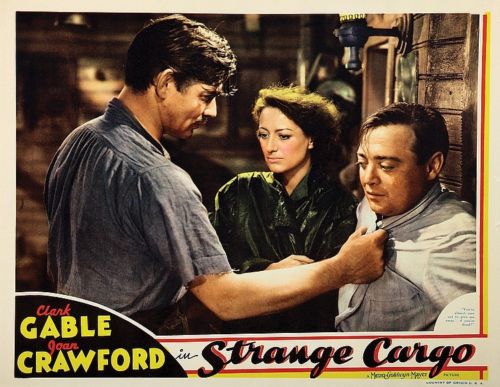





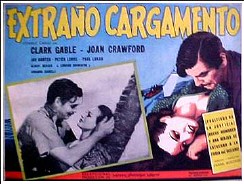
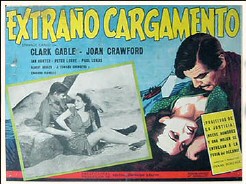
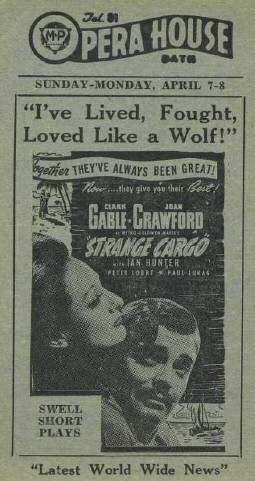
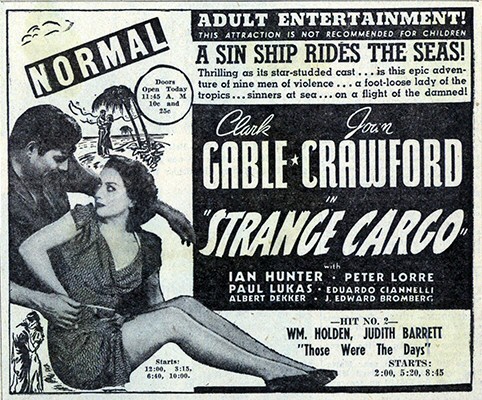
Above: US newspaper ads.
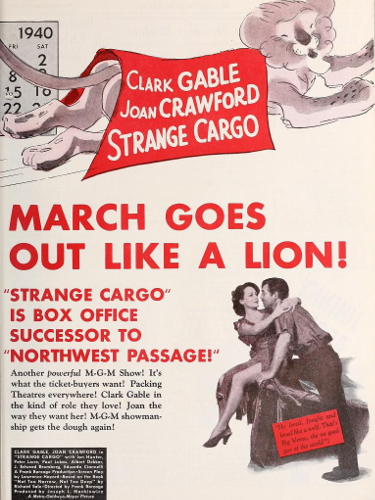
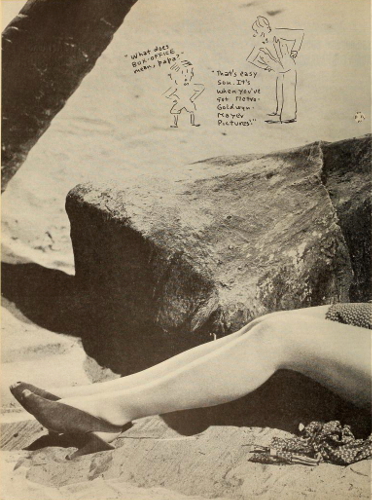

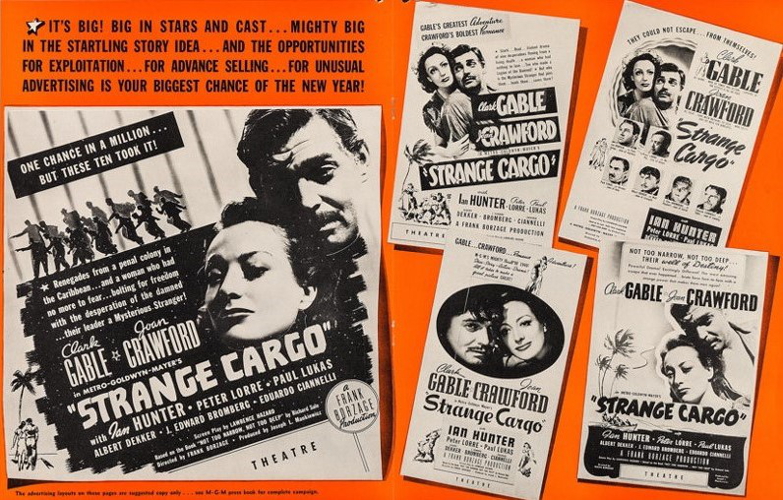
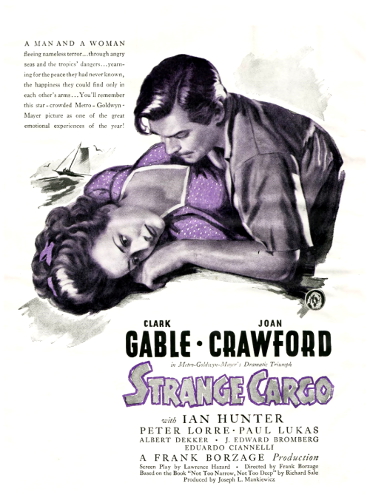
Above: Three US trade ads, and a Photoplay ad (lower right).

Above: US herald.


Above: Danish program.
Above left: A US lantern slide (3-1/4 inches by 4 inches) Above right: 1936 hardcover by Richard Sale. See this site's Books Related to Joan Movies page for more info.

Above: A 1940 Seattle, Washington, postcard with "Strange Cargo" featured on marquee at right.
The Best of Everything